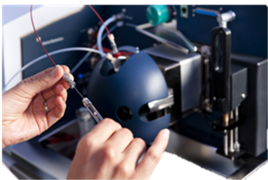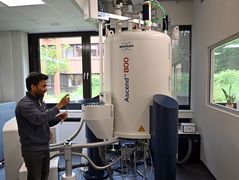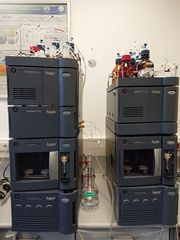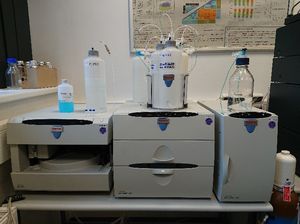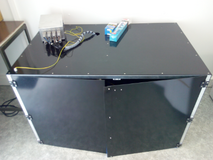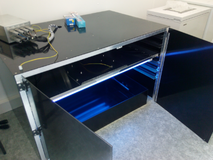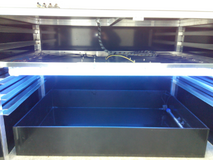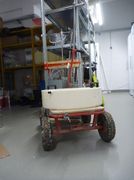Lab Infrastructure
Lab Infrastructure
Our group hosts various tools for sampling and analysis of complex organic mixtures, such as dissolved organic matter (DOM). Central to the group are an ultrahigh-resolution 15 Tesla FT-ICR mass spectrometer and a high-field 800 MHz NMR spectrometer for the molecular characterization of complex organic mixtures. Continuous method development for molecular analyses and data evaluation are core tasks of the working group.
Fourier-transform ion cyclotron resonance mass spectrometry (FT-ICR-MS)
Dissolved organic matter is a highly complex mixture and deciphering its molecular-level composition represents an analytical challenge. Fourier-Transform Ion Cyclotron Resonance Mass Spectrometry (FT-ICR-MS) coupled to electrospray ionization is a valuable tool which can resolve the exact masses of intact molecules. We operate a Bruker Solarix XR with a 15 Tesla magnet. Electrospray Ionization (ESI) or Atmospheric Pressure Chemical Ionization (APCI) sources are available to ionize nonpolar to very polar compounds. The dynamically harmonized ParaCell allows the acquisition of spectra at extreme resolution (R>10,000,000). For routine analyses of large sample sets, a CTC PAL 3 autosampler can be connected to the instrument. Continuous method development and data evaluation routines for molecular formula assignment to the thousands of peaks detected per spectrum are core tasks within the working group.
Applications:
- Dissolved organic matter molecular composition from marine or freshwater environments or laboratory experiments
- Characterization of oils and asphaltenes
- MS-MS experiments to characterize core structures
- Natural products characterization
Selected publications:
Zark, M, Christoffers J and Dittmar T (2017). Molecular properties of deep-sea dissolved organic matter are predictable by the central limit theorem: evidence from tandem FT-ICR-MS. Marine Chemistry 191, 9-15.
Waska H, Koschinsky A and Dittmar T (2016) Fe- and Cu-complex formation with artificial ligands investigated by ultra-high resolution Fourier-transform ion cyclotron resonance mass spectrometry (FT-ICR-MS): Implications for natural metal-organic complex studies. Frontiers in Marine Science 3:1-19.
Pohlabeln A and Dittmar T (2015) Novel insights into the molecular structure of non-volatile marine dissolved organic sulfur. Marine Chemistry 168, 86-94.
Dittmar T and Paeng J (2009) A heat-induced molecular signature in marine dissolved organic matter. Nature Geoscience 2, 175-179.
Koch BP, Dittmar T, Witt M and Kattner G (2007) Fundamentals of molecular formula assignment to ultrahigh resolution mass data of natural organic matter. Analytical Chemistry 79, 1758-1763.
Contact:
Katrin Klaproth
Campus Wechloy
W3-0-181B
(+49) 441 - 798 3773
fticrms@uni-oldenburg.de
Nuclear Magnetic Resonance (NMR) Spectroscopy
High-field nuclear magnetic resonance (NMR) spectroscopy is an invaluable tool for molecular-level structural analysis of marine dissolved organic matter (DOM), a highly complex organic mixture. Our lab is equipped with state-of-the-art NMR instrumentation, commissioned in December 2023, specifically dedicated to advancing marine DOM research. We focus on developing and applying advanced NMR methods to explore the molecular composition and dynamics of DOM across various aquatic environments.
Key Features:
- Instrumentation: Bruker Avance Neo 800 MHz NMR spectrometer
- Cryoprobes:
- 5 mm TCI (Triple Resonance Inverse)
- 1.7 mm TCI (Triple Resonance Inverse)
- 5 mm BBO (Broadband Observe)
- Nuclei: 1H, 13C, 19F and 15N-31P
- Autosampler: Equipped with a 24-position SampleCase for efficient sample processing.
Application:
- Gaining a mechanistic understanding of DOM turnover and long-term storage in the ocean
- Unraveling the molecular diversity of DOM across the oceans
- Conducting detailed analysis of the exometabolome obtained from laboratory culture experiments
- Efficiently characterizing marine dissolved organic phosphorous (DOP) and dissolved organic nitrogen (DON)
Selected publications:
Vemulapalli SPB, Griesinger C and Dittmar T (2023) Expanding the limits of structural characterization of marine dissolved organic matter using nonuniform sampling frequency-reversed edited HSQC NMR. Analytical Chemistry 95, 14770–14776. https://doi.org/10.1021/acs.analchem.3c02923
Vemulapalli SPB, Griesinger C and Dittmar T (2023) A fast and efficient tool for the structural characterization of marine dissolved organic matter: Nonuniform sampling 2D COSY NMR. Limnology & Oceanography Methods 21, 401–413. https://doi.org/10.1002/lom3.10553
Seidel M, Vemulapalli SPB, Mathieu D and Dittmar T (2022) Marine dissolved organic matter shares thousands of molecular formulae yet differs structurally across major water masses. Environmental Science & Technology 56, 3758-3769. https://doi.org/10.1021/acs.est.1c04566
Vemulapalli SPB, Fuentes-Monteverde JC, Karschin N, Oji T, Griesinger C and Wolkenstein K (2021) Structure and absolute configuration of phenanthro-perylene quinone pigments from the deep-sea crinoid hypalocrinus naresianus. Marine Drugs 19, 445. https://doi.org/10.3390/md19080445
Contact:
Sahithya Phani Babu Vemulapalli
Campus Wechloy
ROOM: W03A 0-170
PHONE: (49) 441-798-3398
E-MAIL: sahithya.phani.babu.vemulapalli@uni-oldenburg.de
Dissolved organic carbon (DOC) / Dissolved organic nitrogen (DON) Analyzer
The Shimadzu Analysers provide information on the bulk concentration of Dissolved Organic Carbon (DOC, defined as organic carbon that passes through a 0.7 µm filter) and total dissolved nitrogen (TDN). Based on the “high-temperature combustion method” (720°C), organic carbon is oxidized completely to CO2, which is susequently measured with an Infra-Red Detector. Nitrogen in organic molecules and inorganic forms of nitrogen (TDN) are equally oxidized, and detected as NO2 via chemoluminescence.
Analyses are routinely performed with water from various locations, i.e. open ocean, north sea, black sea, lakes, rivers, swamps, hydrothermal vents, etc. Also analysis of samples with specific requirements is possible, e.g. measuring the DOC/TDN content of hailstones in extremely low volumes (100 µL).
List of people involved:
Selected publications:
Sugimura and Suzuki (1988): A high-temperature catalytic oxidation method for the determination of non-volatile dissolved organic carbon in seawater by direct injection of a liquid sample. Marine Chemistry 24: 105-131
Aron Stubbins and Thorsten Dittmar (2012) Low volume quantification of dissolved organic carbon and dissolved nitrogen. Limnol. Oceanogr.: Methods 10, 2012, 347–352
Ultra performance liquid chromatography (UPLC)
Dissolved organic matter contains a suite of organic molecules that can be separated and quantified using liquid chromatography. Prominent examples are individual amino acids and carbohydrates. There are also components in DOM that can be traced through characteristic products after specific chemical treatment, e.g. dissolved lignin (lignin phenols) and dissolved black carbon (benzenepolycarboxylic acids).
Ultra performance liquid chromatography (UPLC) uses the principles of high performance liquid chromatography (HPLC) but works with pressures of up to 1000 bar. Applying such high pressure, particle sizes in the separation columns can be much smaller (< 2 µm), which increases separation while reducing run time, sample volume and solvent use.
UPLC system I:
Waters Acquity UPLC®: Binary Solvent Manager, Sample Manager, Column Manager, PDA eλ Detector
UPLC system I is equipped with a photodiode array absorbance detector. This system is used for routine analysis of benzenepolycarboxylic acids (BPCA). The column manager can hold up to four different separation columns, providing a helpful tool for method development.
UPLC system II:
Waters Acquity UPLC®: Binary Solvent Manager, Sample Manager, FLR Detector
UPLC system II is equipped with a fluorescence detector. Main application of this system is amino acid analysis.
Contact:
Jutta Niggemann
W3-1-218
0441 - 798 3365
jutta.niggemann@uni-oldenburg.de
Key publications:
Benzenepolycarboxylic acids (dissolved black carbon):
Dittmar, T. (2008) The molecular level determination of black carbon in marine dissolved organic matter. Organic Geochemistry 39: 396-407
Jaffé, R., Ding, Y., Niggemann, J., Vähätalo, A.V., Campbell, J., Dittmar, T. (2013) Global charcoal mobilization from soils via dissolution and riverine transport to the oceans. Science 340(6130): 345-347
Lignin phenols (lignin):
Chmiel, H.E., Niggemann, J., Kokic, J., Ferland, M.-E., Dittmar, T., Sobek, S. (2015) Uncoupled organic matter burial and quality in boreal lake sediments over the Holocene. Journal of Geophysical Research: Biogeosciences 120: 1751-1763
De la Cruz, F.B., Dittmar, T., Niggemann, J., Osburn, C.L., Barlaz, M.A. (2015) Evaluation of copper oxide oxidation for quantification of lignin in municipal solid waste. Environmental Engineering Science 32: 486-496
High performance liquid chromatography (HPLC)
Dissolved organic matter contains a suite of organic molecules that can be separated and quantified using liquid chromatography. Prominent examples are individual amino acids and carbohydrates.
Carbohydrate analysis uses a specific HPLC application called high-performance anion-exchange chromatography (HPAE), working at high pH and using strong anion exchange stationary phases. Pulsed amperometric detection (PAD) is an electrochemical detection method that has been optimized for carbohydrate analysis.
Thermo Scientific Dionex ICS-5000+: SP Single Pumps (gradient pump with degassing unit), DC Chromatography Compartment, ED Electrochemical Detector, AS-AP Autosampler.
Contact:
Jutta Niggemann
W3-1-218
0441 - 798 3365
jutta.niggemann@uni-oldenburg.de
UV Bench
To study photochemical transformation of dissolved organic molecules under controlled conditions, we have set up a closed irradiation.
The setup consists of several parts:
- Black box to shield environment from UV irradiation
- Water bath with heater and flow-through pump to keep temperature level constant, a fan is mounted on the back wall for air exchange
- 8 UVA-340 fluorescent tubes (Q-Lab), distance to sample can be adjusted
- Quartz tubes (~170 mL volume) to irradiate aqueous samples
Contact:
Michael Seidel
W16-0-005
0441 - 798 3768
m.seidel@uni-oldenburg.de
Field Equipment
Our lab routinely performes sampling at field sites e.g. in the North and Wadden Sea, such as Janssand tidal flat or Spiekeroog beach. These environment require specific equipment to facilitate research campaigns, which are available and frequently used in our group. A suite of sturdy stainless steel push-point samplers for pore water collection have been developed which can be deployed at different sediment depths (< 2 m), and be quickly retrieved. They are equipped with 50 µm mesh nets to minimize sediment entrainment. Also, sampling under exclusion of oxygen is possible, by using a tightly sealed pumping system and inline filters. Seepage meters for the collection of submarine groundwater discharge were designed to be trace-metal free.
Our instrumentation also includes a field fluorometer (Aquafluor, Turner instruments), a GPS (Garmin Colorado 400c), and a water-proof camera.
List of people involved:
Roger Carvalho
Matthias Friebe
Michael Seidel
Heike Simon
Hannelore Waska
Key publications:
H. Waska, J. Greskowiak, J. Ahrens, M. Beck, S. Ahmerkamp, P. Böning, H.-J. Brumsack, J. Degenhardt, C. Ehlert, B. Engelen, N. Grünenbaum, M. Holtappels, K. Pahnke, H. K. Marchant, G. Massmann, D. Meier, B. Schnetger, K. Schwalfenberg, H. Simon, V. Vandieken, O. Zielinski, T. Dittmar (2019). Spatial and temporal patterns of pore water chemistry in the inter-tidal zone of a high energy beach. Front. Mar. Sci. 6: 154
A. Linkhorst, T. Dittmar, H. Waska (2017) Molecular fractionation of dissolved organic matter in a shallow subterranean estuary: The role of the iron curtain. Environ. Sci. Technol. 51 (3), 1312-1320.
M. Seidel, M. Beck, J. Greskowiak, T. Riedel, H. Waska, I. G. N. Suryaputra, B. Schnetger, J. Niggemann, M. Simon, and T. Dittmar (2015) Benthic-pelagic coupling of nutrients and dissolved organic matter composition in an intertidal sandy beach. Mar. Chem. 176: 150-163.
Contact:
Dr. Hannelore Waska
Campus Wechloy
W3-1-219
0441 - 798 3348
hannelore.waska@uni-oldenburg.de

![[Translate to English:]](/f/5/_processed_/3/2/csm_ICBM-Logo-transparent-_91fe1c6774.png)

